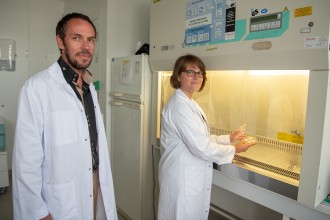Discovery: hormone receptors in fungi
Microscopic fungi have receptors called "histidine kinases" on their cell membranes that enable them to detect hormones in the different hosts they colonise. This is what researchers at the GEIHP in Angers have discovered. Their work has given rise to a "Collaborative Research Project-Companies" (PRCE), funded by the French National Research Agency. A first for the AU.
The GEIHP (Groupe d'étude des interactions hôte-pathogène), one of the research units of the Anjou health cluster, has been working for many years to elucidate the molecular mechanisms that enable filamentous fungi to colonise the respiratory tracts of cystic fibrosis patients. "Understanding how these fungal microorganisms perceive the host's chemical signals and adapt to the host is at the heart of our concerns, explains Nicolas Papon, Professor of Parasitology and Medical Mycology. This knowledge of cellular mechanisms could ultimately lead to better management of fungal infections in patients."
Fighting fungal infections
Before being recruited by the Faculty of Health of Angers's university in September 2015, Nicolas Papon had specialised in a family of receptors called 'histidine kinase'. These receptors are present on the cell membrane of most microorganisms and enable them to perceive environmental signals.
.

Nicolas Papon et Anaïs HérivauxNicolas Papon and Anaïs Hérivaux "A few weeks after my arrival at the GEIHP," recalls Nicolas Papon, "my doctoral student Anaïs Hérivaux and I were lucky enough to make a major discovery in the field of mycology: certain groups of microscopic fungi possess histidine kinase receptors that perceive various hormones known to be involved in inter-species communication, whether symbiosis or pathogenicity".
This type of receptor had never before been observed in fungi. The Angevine discovery was the subject of a major publication in January 2017 in the journal mBio. It opens up prospects in the fields of biotechnology (hormone detection and dosage) and infectiology, as the receptors could act as gateways to counter the pathogenic effect of fungi. "We anticipate that these receptors will become therapeutic targets for the development of new antimicrobials, enabling us to provide better treatment for fungal infections in the future".
ANR funding
This work has also formed the basis of a project called "Mycormones". Funded this autumn for 3 years by the French National Research Agency (ANR) under the heading of "Collaborative Research Projects-Companies", it brings together the AU, the University of Toulouse and a biotechnology company from Haute-Garonne.
The objectives in Anjou will be to study the function of these receptors in fungi, "what they orchestrate", using various genetic and microbiological engineering approaches.
About PRCE
The "Collaborative Research Projects - Enterprise" (PRCE) funding instrument is dedicated to effective collaborations established between at least one French public or assimilated research organisation and at least one French commercial company conducting research and development work in France. The aim of this collaboration is to jointly achieve research results that will benefit both parties, by enabling public research bodies to tackle new research questions, or to tackle them in a different way, and by giving companies carrying out R&D work access to top-level public research in order to improve their capacity for innovation in different ways.


